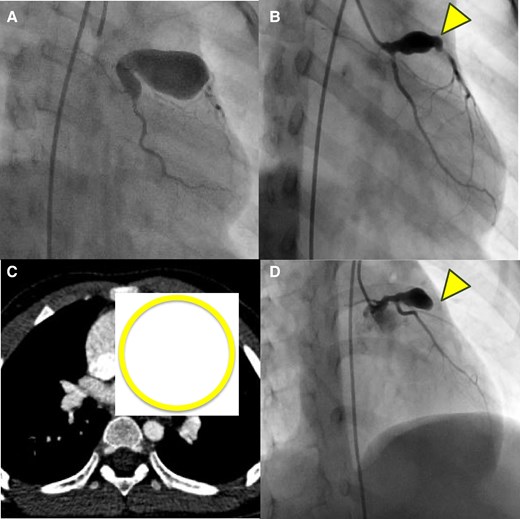-
PDF
- Split View
-
Views
-
Cite
Cite
Takahiro Maeda, Sho Imai, Tomohiro Nawa, Coronary artery aneurysm and early calcification in Kawasaki disease with METTL23 mutation, European Heart Journal - Case Reports, Volume 9, Issue 5, May 2025, ytaf195, https://doi.org/10.1093/ehjcr/ytaf195
Close - Share Icon Share
A 1-year and 3-month-old boy with intellectual developmental delay presented with fever for 2 days. The clinical findings included conjunctival erythema, strawberry tongue, non-suppurative lymphadenopathy, and an atypical skin rash, leading to a diagnosis of Kawasaki disease. The patient received intravenous high-dose immunoglobulin therapy (2 g/kg/dose) on Days 2 and 4 of fever but was intravenous immunoglobulin therapy (IVIG)-resistant. Additionally, he received methylprednisolone pulse therapy on Day 6, IVIG on Days 10 and 17, and infliximab on Day 18. On Day 15, giant coronary artery aneurysms measuring 11 mm in Segment 1 and 12 mm in Segment 6, were identified (Figure 1A). The patient was treated with warfarin, aspirin, and angiotensin receptor blockers and no clinical events occurred. However, computed tomography (CT) and coronary angiography performed at 3 years and 3 months (Figure 1B and C, respectively) revealed calcification in the left anterior descending artery. Follow-up echocardiography at 4 years and 2 months suggested progressive thrombus formation and calcification, prompting repeat CT imaging at 4 years and 3 months. The calcification had advanced, and coronary angiography revealed 99% stenosis in Segment 6 (Figure 1D). Electrocardiographic changes were observed during the tests. Severe stenotic lesions and clinical signs of ischaemia were observed, indicating the need for coronary artery bypass grafting. Therefore, a left internal thoracic artery to left anterior descending artery (LITA-LAD) bypass was performed at 4 years and 5 months. The patient was discharged on post-operative Day 7, and the graft remained patent with a favourable clinical course. Genetic testing for developmental delay identified a METTL23 mutation that has been associated with intellectual disabilities, leading to the diagnosis of autosomal recessive intellectual developmental disorder.

Course of coronary artery aneurysm in this case. Giant coronary aneurysm in Segment 1 and 6 (A). Coronary aneurysm in Segment 6 two years after onset (B, C). Coronary aneurysm in Segment 6 three years after onset (D).
According to Yang et al.,1 the METTL23 mutation affects histone H3R17 methylation and is linked to NF-κB-mediated Tumor Necrosis Factorα and IL1B transcription. To date, there have been no reports of Kawasaki disease in patients with METTL23 mutations. The impact of this mutation on Kawasaki disease remains unclear, though its role in this patient’s refractory course, sequelae, and early calcification may be significant.
Consent: This case report was written with patient consent and is in accordance with COPE guidelines.
Funding: None declared.
Data availability
The data underlying this article will be shared on reasonable request to the corresponding author.
Reference
Author notes
Conflict of interest. None declared.




Comments